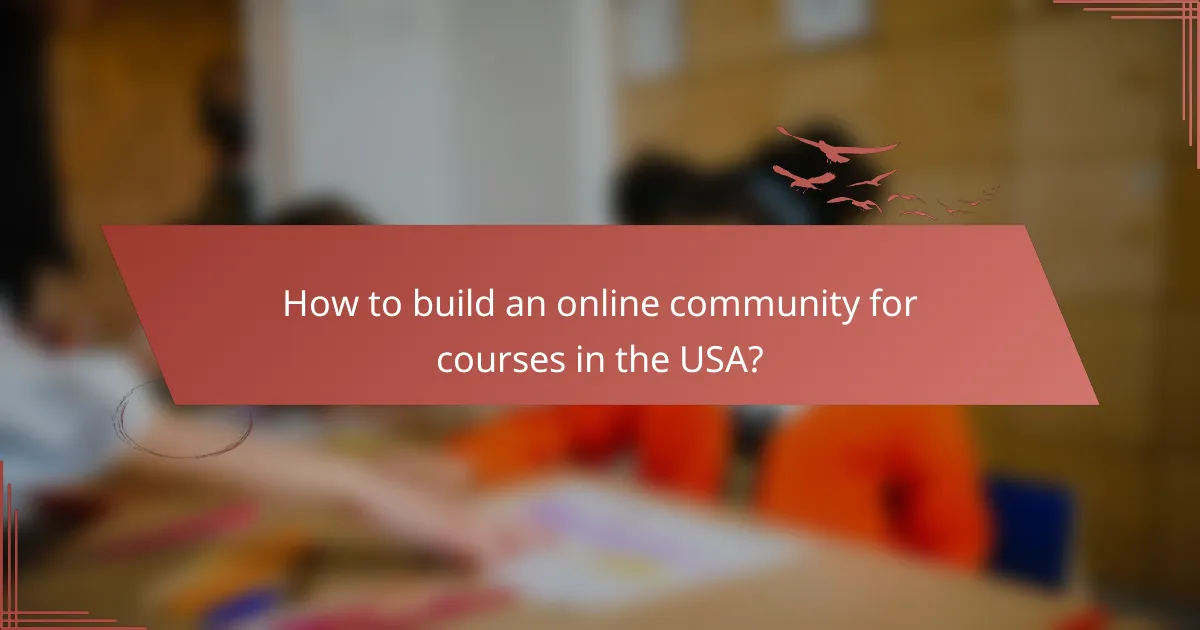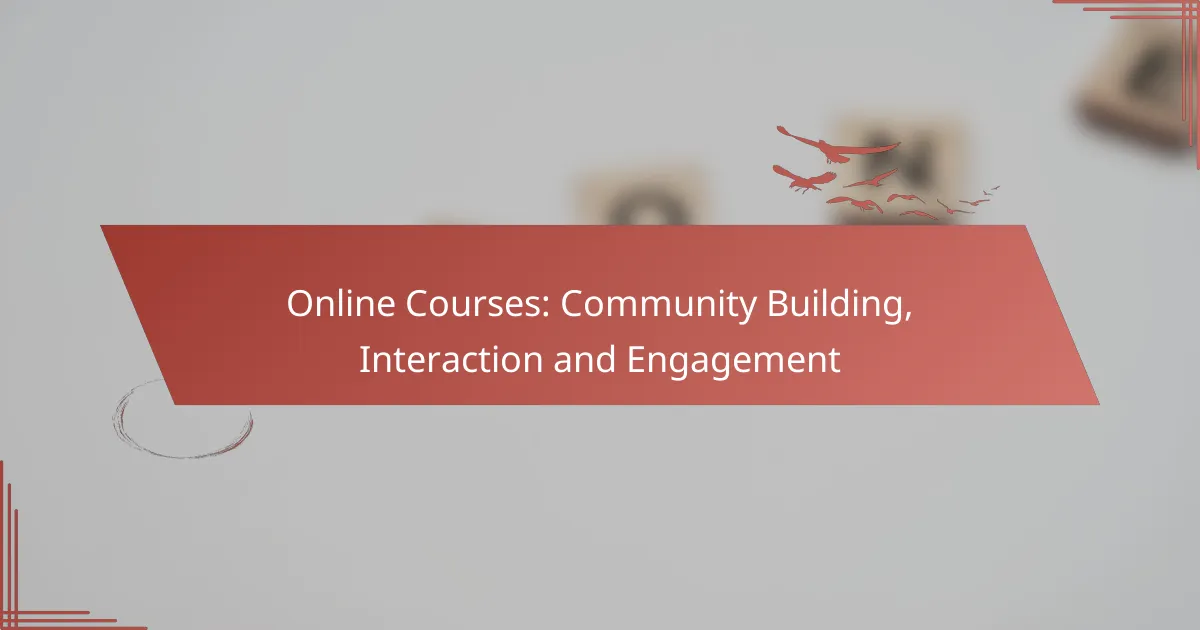Creating an online community for courses in the USA is essential for fostering interaction and engagement among learners. By implementing effective strategies such as interactive live sessions and gamification, educators can enhance the learning experience and cultivate a supportive environment where participants feel connected and motivated.

How to build an online community for courses in the USA?
Building an online community for courses in the USA involves creating a space where learners can interact, share experiences, and support each other. Effective community building enhances engagement and fosters a sense of belonging among participants.
Utilize social media platforms
Social media platforms like Facebook, Instagram, and LinkedIn can be powerful tools for fostering community around your online courses. Create dedicated groups or pages where learners can discuss course content, share resources, and connect with one another.
Encourage participants to share their progress and insights, which can help motivate others. Regularly post updates, polls, or questions to keep the conversation flowing and maintain engagement.
Create dedicated forums
Dedicated forums provide a structured environment for discussions and inquiries related to your courses. Platforms like Discourse or even a simple WordPress forum can facilitate topic-specific threads where learners can ask questions and share knowledge.
Ensure that the forum is user-friendly and actively moderated to maintain a positive atmosphere. Consider setting up categories based on course modules or themes to help users navigate easily.
Leverage community management tools
Community management tools like Slack, Discord, or Mighty Networks can enhance interaction and engagement among course participants. These platforms allow for real-time communication and can be tailored to suit the specific needs of your community.
Utilize features such as channels for different topics, direct messaging, and event scheduling to keep members engaged. Regularly check in and gather feedback to improve the community experience and address any concerns promptly.

What are effective engagement strategies for online courses?
Effective engagement strategies for online courses include interactive live sessions, gamification techniques, and regular feedback loops. These approaches foster a sense of community, enhance interaction, and keep learners motivated throughout their educational journey.
Interactive live sessions
Interactive live sessions allow instructors and students to engage in real-time discussions, making the learning experience more dynamic. These sessions can include Q&A segments, polls, and breakout rooms for small group activities, which encourage participation and collaboration.
To maximize engagement, schedule these sessions at convenient times for your audience, and keep them relatively short—typically between 30 to 60 minutes. This helps maintain focus and energy levels among participants.
Gamification techniques
Gamification techniques involve incorporating game-like elements into the learning process to boost motivation and engagement. This can include point systems, badges, leaderboards, and challenges that reward learners for completing tasks or achieving milestones.
When implementing gamification, ensure that the rewards are meaningful and aligned with the course objectives. For example, offering a certificate for completing a series of challenges can incentivize learners to participate actively.
Regular feedback loops
Regular feedback loops are essential for maintaining engagement in online courses. Providing timely and constructive feedback helps learners understand their progress and areas for improvement. This can be achieved through quizzes, peer reviews, or instructor comments.
Consider scheduling feedback sessions after major assignments or assessments to keep learners informed and motivated. Aim to provide feedback within a week of submission to ensure it remains relevant and actionable.

How can online courses enhance student interaction?
Online courses can significantly enhance student interaction by providing various platforms and tools that encourage communication and collaboration. These features foster a sense of community, making learning more engaging and effective.
Discussion boards
Discussion boards serve as a vital tool for student interaction in online courses. They allow learners to post questions, share insights, and engage in discussions at their own pace. This asynchronous communication helps students articulate their thoughts and receive feedback from peers and instructors.
To maximize the effectiveness of discussion boards, instructors should establish clear guidelines for participation, such as response times and the quality of contributions. Encouraging students to respond to each other can deepen understanding and create a more vibrant learning environment.
Peer-to-peer learning opportunities
Peer-to-peer learning opportunities facilitate direct interaction among students, allowing them to learn from one another. This can take the form of study groups, peer reviews, or informal mentoring. Such interactions often lead to a richer educational experience as students share diverse perspectives and problem-solving approaches.
To implement effective peer-to-peer learning, consider assigning students to small groups based on their interests or skill levels. Providing structured activities or prompts can help guide these interactions and ensure that all participants contribute meaningfully.
Collaborative projects
Collaborative projects encourage students to work together towards a common goal, enhancing their interaction and teamwork skills. These projects can range from group presentations to joint research assignments, fostering a sense of accountability and shared responsibility among participants.
When designing collaborative projects, it’s crucial to define roles and expectations clearly. Using tools like shared documents or project management software can help streamline communication and keep everyone on track. Regular check-ins can also ensure that all group members are engaged and contributing effectively.

What tools facilitate community building in online education?
Several tools are essential for fostering community building in online education, enhancing interaction and engagement among learners. These tools streamline communication, facilitate collaboration, and create a sense of belonging within virtual classrooms.
Moodle for course management
Moodle is a widely used Learning Management System (LMS) that supports course management, content delivery, and student engagement. It allows educators to create structured courses with resources, assignments, and forums, enabling students to interact with course materials and each other.
With features like discussion boards and group activities, Moodle encourages collaboration among students. Educators can track participation and progress, making it easier to identify students who may need additional support.
Slack for communication
Slack is a popular communication platform that enhances real-time interaction among students and instructors. It allows for the creation of channels dedicated to specific topics, enabling focused discussions and quick information sharing.
Using Slack, educators can facilitate informal conversations and encourage peer-to-peer support. Its integration with other tools and file-sharing capabilities make it a versatile option for enhancing community engagement in online courses.
Zoom for live interactions
Zoom is a leading video conferencing tool that enables live interactions, crucial for building community in online education. It allows for virtual classrooms where students can engage in discussions, ask questions, and participate in group activities in real-time.
Instructors can use features like breakout rooms for small group discussions, fostering deeper connections among students. Scheduling regular live sessions can help maintain engagement and provide opportunities for immediate feedback and interaction.

What are the prerequisites for successful online community engagement?
Successful online community engagement requires clear communication and defined goals. These elements foster an environment where members feel valued and motivated to participate actively.
Clear communication guidelines
Establishing clear communication guidelines is essential for fostering engagement within an online community. These guidelines should outline acceptable behavior, preferred communication channels, and response times to ensure that all members understand how to interact effectively.
For example, a community might specify that all discussions should take place in designated forums rather than private messages to maintain transparency. Additionally, setting expectations for response times can help manage member engagement and prevent frustration.
Defined community goals
Defined community goals provide direction and purpose, helping members understand what they are working towards. These goals should be specific, measurable, attainable, relevant, and time-bound (SMART) to encourage participation and track progress.
For instance, a community focused on professional development might aim to host monthly webinars, with a goal of increasing attendance by a certain percentage each quarter. Regularly revisiting these goals can help keep the community aligned and motivated.
